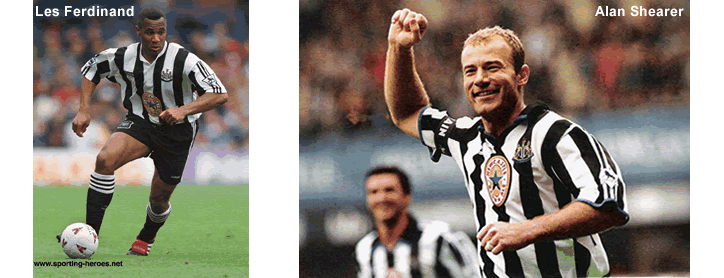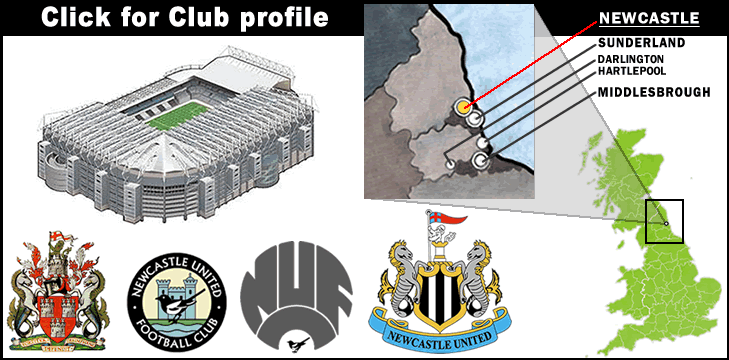…
In 1881, the Stanley Cricket Club of Byker (an inner-city ward of Newcastle) decided to form an off-shoot of the club, to play football during the winter. In 1882, they changed the name to Newcastle East End FC. Another cricket club in the city formed Newcastle West End FC, also in 1882. East End turned professional in 1889. West End avoided dissolution by merging with East End, in 1892. This club became Newcastle United FC, and wore red, then red-and white vertically striped jerseys. The club joined the Second Division in 1893. In 1894, they adopted their famous black-and-white vertically striped jerseys, after frequent color clashes with other clubs in red kits. Also, their hated local rivals Sunderland AFC had begun wearing red and white stripes (in 1886). It is for this black and white scheme that the club is known as the Magpies. In 1898, Newcastle was elected to the First Division. By the early 1900′s, with a squad dominated by Scotsmen, Newcastle became a football power. They won the League Title in 1905, 1907, and 1909. In the FA Cup, Newcastle were runners-up in 1905, 1906, and 1908. They won their first FA Cup in 1910, beating Barnsley 1-0, in the re-play at Goodison Park (in Liverpool). They were runners-up in this competition again in 1911. The FA Cup Finals, from 1895 to 1914, were played at the old Crystal Palace, in south London. Newcastle played 6 Finals there, the most of any club.

Newcastle’s form dropped after that, and for the next 13 seasons they were basically a mid-table club. They won their second FA Cup in 1924, defeating Aston Villa 2-0, at the old Wembley Stadium. Three years later (1927), Newcastle won the League Title, their fourth. And the Magpies won their third FA Cup in 1932, with a 2-1 victory over Arsenal. However, they were relegated two years later. From 1935 to 1939/1946 to 1948 (7 league seasons, with WW II in between), Newcastle was in Division Two. Their first season back in the top flight, 1948, Newcastle had an astounding average gate of 53,800, the nation’s highest. The club won back to back FA Cups in 1951 (2-0, over Blackpool), and 1952 (1-0, over Arsenal). By the mid-fifties, the club was mired in the bottom half of the league table, but they still won the FA Cup again, in 1955 beating Manchester City 3-1. {see this newsreel of the 1955 FA Cup} The club was led by Jackie Milburn and Bobby Mitchell. This was their sixth FA Cup. It was also their last major trophy.

Through the late 1950′s, the club continued to slide down the league table, and was relegated in 1961. They returned to the First Division in 1965, but remained as a bottom-half-of-the-table club. However, they did win the Inter-City Fairs Cup in 1969. This defunct trophy was the forerunner of the UEFA Cup (the second echelon championship of Europe). They defeated Sporting (Lisbon), Feyenoord, Zaragoza, and Rangers on the way, and Ujpest, of Hungary, in the final. The squad was led by Welshman Wyn Davis. The Fairs Cup is not recognized by UEFA as a trophy. The Magpies made it to 2 “real” Cup finals in the 70′s, though. But they lost both: the FA Cup, in 1974, to Liverpool; and the League Cup, in 1976, to Manchester City. From 1971-76, Malcolm McDonald was the driving force, scoring 97 goals in 5 seasons. But Newcastle was relegated once again, in 1977. After 6 seasons they were promoted back to the first tier, in 1984. It was Kevin Keegan, in the twilight of his famous career, who led the club back up. {see this 1983-84 highlight reel. There are nice background views of St. James’ Park at the link. Even then, the stadium had a lop-sided shape, with some large stands, and some smaller. (#9 in some of the goals is Chris Waddle)}

But it was back to the second level in 1989, with the club in massive debt, and forced to sell off players like Paul Gascoigne. In 1992, Sir John Hall took over the club, and appointed Keegan as manager. His heavy investment in the club saw quick results, as Newcastle went from 20th to 1st place, and were promoted to the new English Premier League, playing an exciting brand of attacking football. The next season, Newcastle continued their impressive form, finishing 3rd best in the country. A dip to 6th place, in 1995, was answered with the signings of David Ginola and Les Ferdinand. In the 1995-96 season, the club looked set to finally regain the crown. They led the league by as much as 12 points, but squandered the lead, and finished second. One game stands out, a 4-3 loss to Liverpool that many call one of the greatest matches ever {see this footage}. The club then signed Geordie Alan Shearer for a then-record 15 million pounds.

The prolific scorer had just led underdog Blackburn Rovers to their first Title in 81 years. Even so, in 1997, Newcastle finished second, again, to Manchester United. More disappointment followed, as Newcastle lost back-to-back FA Cup Finals: to Arsenal 0-2, in 1998, and Manchester United 0-2, in 1999. Sir Bobby Robson became manager in 1999, and the club improved from 13th to 11th to 4th place. In 2003, they finished 3rd, and qualified for the European Champions League. But failure to maintain this level cost Robson his job. For new manager, the board, led by Chairman Freddy Shepherd, made an uninspired choice: the authoritarian Graeme Souness. The taciturn Scot had left the Liverpool clubhouse rife with dissension, in the early 90′s; he left Blackburn in 2004 with bitterness all around, and the situation at Newcastle played out similarly. Although the club made it to the semi-finals in the UEFA Cup and the FA Cup in 2005, by February, 2006, Newcastle was near the foot of the table, and Souness was sacked. The signing of 2001 European Player of the Year Michael Owen had helped, but Owen was constantly being injured. Glen Roeder was the next manager, and was instrumental in turning their season around: they finished 7th. But injuries helped make the 2006-07 season into a disaster: 13th place, and Roeder resigned. Sam Allardyce, former manager of the Bolton Wanderers, was hired. Allardyce had worked wonders with Bolton, a medium-sized club that was traditionally a second division team. He relished the opportunity to manage a big club, like Newcastle, with a big transfer kitty. New ownership emerged during the summer of 2007. Mike Ashley, a retail billionaire, took over controlling shares of the club, and appointed Chris Mort, in place of Freddy Shepherd, as Chairman. Newcastle is now one of the richest clubs in England. But big spending has not won anything during the half-century of underachievement that is Newcastle United. This is a club that pulls in 50,000 per game, but continues to win nothing but media overexposure. Bitter Geordie fans in the Toon Army are already calling for Allardyce’s head, as the club sits in 11th place. You would think Newcastle supporters would give someone a little more time than 12 games to turn around a club that for 50 years has produced nothing but dashed hopes.
Thanks to Historical Football Kits, for the 5 older jerseys on the chart, reproduced by permission (historicalkits[dot]co[dot]uk); Colours Of Football, for the 3 sets of newer kits (colours-of-football[dot]com); Photos: (soccerati[dot]net); (nufc[do]pics[dot]com),;(empics[dot]co[dot]uk, (stadiumguide[dot]com); (sporting-heroes[dot]net).

